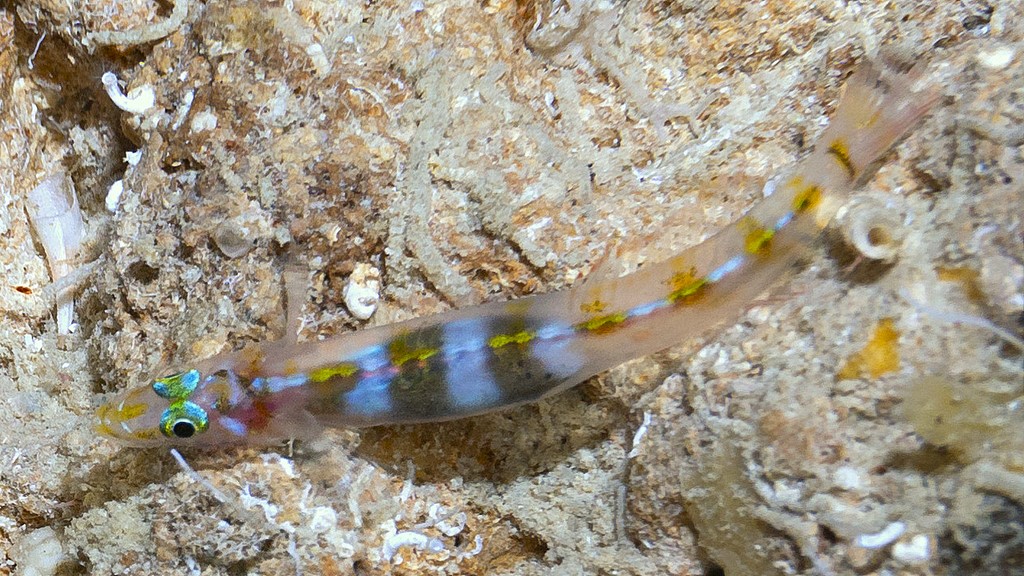ROTUMA LEWISI - (SPRINGER, 1988)
Picture courtesy of: Damien Brouste
Actinopterygii (Gigaclass) > Actinopteri (Class) > Teleostei (Subclass) > Gobiiformes (Order) > Xenisthmidae (Family) > Rotuma (Genus)
Actinopterygii (Gigaclass) > Actinopteri (Class) > Teleostei (Subclass) > Gobiiformes (Order) > Xenisthmidae (Family) > Rotuma (Genus)
Lewis’s wriggler,
Description
First dorsal spines (total): 5; Second dorsal fin (total): 1 spine, 9 rays, all unbranched; Anal spine: 1; Anal soft rays: 9 rays, all unbranched; Pectoral fin rays: 16. Pelvic fins with rudimentary spine: 5 rays, all rays unbranched and inner ray vestigial. No scales on head or body, and no sensory pores on head. Vertebrae: 11 + 15. Max. length: 3.0 cm TL. Depth range: 10 - 53 m.
Color
Head, body and paired fins transparent; Snout, lips and upper part of head yellow; Iris yellowish grey, with pale yellow ring around pupil; Abdomen yellow, with scattered melanophores; Six yellow spots on midsides, underlain with melanophores, and posterior five spots with indistinct yellow to orange bars extending dorsally (to first dorsal fin, interdorsal space, second dorsal-fin origin, end of second dorsal fin, and midpeduncle, respectively); First dorsal fin with orange distal margin and spot at origin; Second dorsal fin with orange to red distal margin and mid-row of orange to red spots; Anal fin similar to second dorsal fin, but fainter; Caudal fin white, becoming transparent posteriorly, with narrow black bar on hypural margin, and this edged with broad red bar, and another less distinct red bar through rear third of fin.
Etymology
Rotuma: the generic name is derived from the island of Rotuma, where both known specimens were collected (type locality).
lewisi: named for Dr. Antony D. Lewis Fisheries Officer, Government of Fiji, for his support of Springer’s field work in Fiji.
Original description: Rotuma lewisi Springer, 1988 - Type locality: isolated patch reef west of wharf, northeastern corner of Rotuma Island, 12°30'S, 177°05'E, southwestern Pacific, depth 10.7 meters.
Distribution
Indo-West Pacific: Comoros; New Caledonia, Rotuma (Fiji).
Biology
Found in cave or isolated patch reef inside lagoon.
Last update: 5, May 2024
Description
First dorsal spines (total): 5; Second dorsal fin (total): 1 spine, 9 rays, all unbranched; Anal spine: 1; Anal soft rays: 9 rays, all unbranched; Pectoral fin rays: 16. Pelvic fins with rudimentary spine: 5 rays, all rays unbranched and inner ray vestigial. No scales on head or body, and no sensory pores on head. Vertebrae: 11 + 15. Max. length: 3.0 cm TL. Depth range: 10 - 53 m.
Color
Head, body and paired fins transparent; Snout, lips and upper part of head yellow; Iris yellowish grey, with pale yellow ring around pupil; Abdomen yellow, with scattered melanophores; Six yellow spots on midsides, underlain with melanophores, and posterior five spots with indistinct yellow to orange bars extending dorsally (to first dorsal fin, interdorsal space, second dorsal-fin origin, end of second dorsal fin, and midpeduncle, respectively); First dorsal fin with orange distal margin and spot at origin; Second dorsal fin with orange to red distal margin and mid-row of orange to red spots; Anal fin similar to second dorsal fin, but fainter; Caudal fin white, becoming transparent posteriorly, with narrow black bar on hypural margin, and this edged with broad red bar, and another less distinct red bar through rear third of fin.
Etymology
Rotuma: the generic name is derived from the island of Rotuma, where both known specimens were collected (type locality).
lewisi: named for Dr. Antony D. Lewis Fisheries Officer, Government of Fiji, for his support of Springer’s field work in Fiji.
Original description: Rotuma lewisi Springer, 1988 - Type locality: isolated patch reef west of wharf, northeastern corner of Rotuma Island, 12°30'S, 177°05'E, southwestern Pacific, depth 10.7 meters.
Distribution
Indo-West Pacific: Comoros; New Caledonia, Rotuma (Fiji).
Biology
Found in cave or isolated patch reef inside lagoon.
Last update: 5, May 2024
